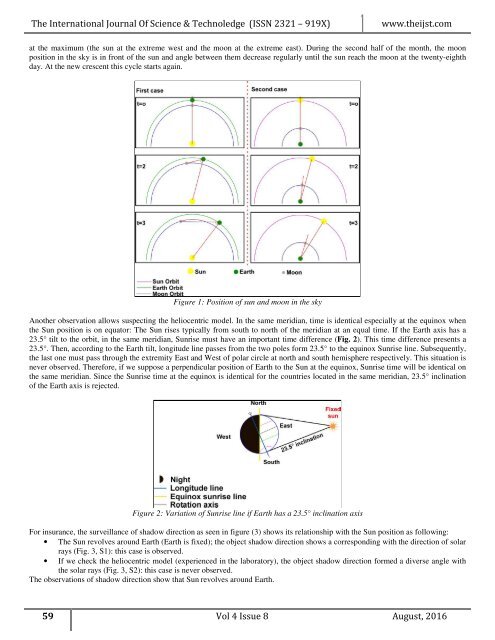9.-ST1608-011
You also want an ePaper? Increase the reach of your titles
YUMPU automatically turns print PDFs into web optimized ePapers that Google loves.
The International Journal Of Science & Technoledge (ISSN 2321 – 919X)<br />
www.theijst.com<br />
at the maximum (the sun at the extreme west and the moon at the extreme east). During the second half of the month, the moon<br />
position in the sky is in front of the sun and angle between them decrease regularly until the sun reach the moon at the twenty-eighth<br />
day. At the new crescent this cycle starts again.<br />
Figure 1: Position of sun and moon in the sky<br />
Another observation allows suspecting the heliocentric model. In the same meridian, time is identical especially at the equinox when<br />
the Sun position is on equator: The Sun rises typically from south to north of the meridian at an equal time. If the Earth axis has a<br />
23.5° tilt to the orbit, in the same meridian, Sunrise must have an important time difference (Fig. 2). This time difference presents a<br />
23.5°. Then, according to the Earth tilt, longitude line passes from the two poles form 23.5° to the equinox Sunrise line. Subsequently,<br />
the last one must pass through the extremity East and West of polar circle at north and south hemisphere respectively. This situation is<br />
never observed. Therefore, if we suppose a perpendicular position of Earth to the Sun at the equinox, Sunrise time will be identical on<br />
the same meridian. Since the Sunrise time at the equinox is identical for the countries located in the same meridian, 23.5° inclination<br />
of the Earth axis is rejected.<br />
Figure 2: Variation of Sunrise line if Earth has a 23.5° inclination axis<br />
For insurance, the surveillance of shadow direction as seen in figure (3) shows its relationship with the Sun position as following:<br />
• The Sun revolves around Earth (Earth is fixed); the object shadow direction shows a corresponding with the direction of solar<br />
rays (Fig. 3, S1): this case is observed.<br />
• If we check the heliocentric model (experienced in the laboratory), the object shadow direction formed a diverse angle with<br />
the solar rays (Fig. 3, S2): this case is never observed.<br />
The observations of shadow direction show that Sun revolves around Earth.<br />
59 Vol 4 Issue 8 August, 2016



